SPREADING THE MESSAGE TO THE SAILING PUBLIC
Errors and omissions excepted
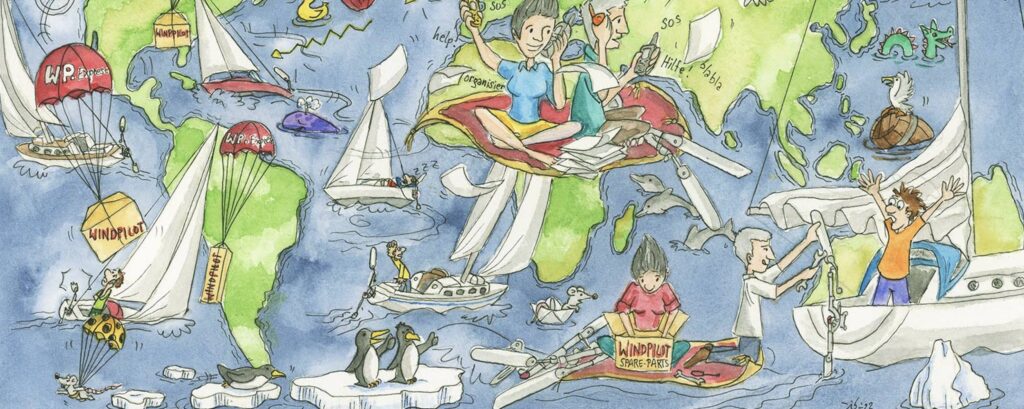 It sometimes seems to me that certain writers in the marine business are not above misusing their purported influence to plant misleading messages in a sailor’s head. I am not tilting at windmills here: the evidence is clear to see. Has any aspect of our industry been scrutinized more thoroughly and exhaustively than windvane self-steering? I very much doubt it: all the information is out there, so technical errors (at least) could easily be avoided – or, failing that, quickly corrected – given a modicum of commitment to accuracy. I, for example, am always happy to help clear up any errors or omissions of which I become aware. Accuracy, therefore, is very much within reach, yet some writers still manage to find their way to unsupportable conclusions. While I cannot always be on hand to guide things back onto the straight and narrow, I am by no means reluctant (!) to share what I have learned over 48 years in the steering slave sector – and today is emphatically a sharing day!
It sometimes seems to me that certain writers in the marine business are not above misusing their purported influence to plant misleading messages in a sailor’s head. I am not tilting at windmills here: the evidence is clear to see. Has any aspect of our industry been scrutinized more thoroughly and exhaustively than windvane self-steering? I very much doubt it: all the information is out there, so technical errors (at least) could easily be avoided – or, failing that, quickly corrected – given a modicum of commitment to accuracy. I, for example, am always happy to help clear up any errors or omissions of which I become aware. Accuracy, therefore, is very much within reach, yet some writers still manage to find their way to unsupportable conclusions. While I cannot always be on hand to guide things back onto the straight and narrow, I am by no means reluctant (!) to share what I have learned over 48 years in the steering slave sector – and today is emphatically a sharing day!
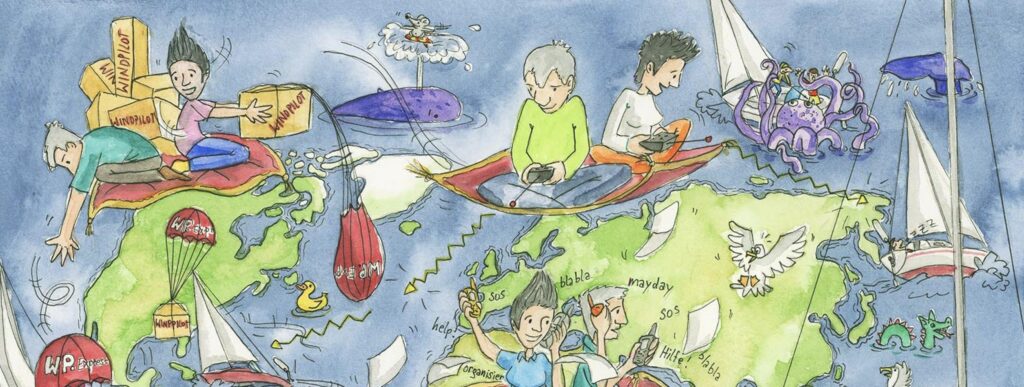 “If you still have questions, I am only ever a mouse click away!” as I have signed off vast numbers of e-mail messages over the years. A busy half a century of active engagement in my market niche has also made a mark on the collective bluewater consciousness, and just about everyone in this little world appears to know that what sells Windpilots is word of mouth within the international cruising community. Making it all the way to the marketing land of milk and honey has taken decades of work, but in the end word of mouth simply cannot be beaten. Happy is the brand that can count on customers for advertising, especially if, like Windpilot, the brand name also becomes established as a synonym for the whole product category. Unburdened of the cost and uncertainty of buying ads in magazines, gambling on sponsorships and the insidious temptations of the advertorial, all I have to do is keep things moving in the workshop and shuttle back and forth to the airport, which I could probably manage in my sleep (if only self-steering was as reliable for cars as it is for sailing boats). The mirror might be showing me a head of white hair these days and even (if the light is bright enough and my better half has been keeping it punitively well-polished) a wrinkle or two, but I really cannot complain.
“If you still have questions, I am only ever a mouse click away!” as I have signed off vast numbers of e-mail messages over the years. A busy half a century of active engagement in my market niche has also made a mark on the collective bluewater consciousness, and just about everyone in this little world appears to know that what sells Windpilots is word of mouth within the international cruising community. Making it all the way to the marketing land of milk and honey has taken decades of work, but in the end word of mouth simply cannot be beaten. Happy is the brand that can count on customers for advertising, especially if, like Windpilot, the brand name also becomes established as a synonym for the whole product category. Unburdened of the cost and uncertainty of buying ads in magazines, gambling on sponsorships and the insidious temptations of the advertorial, all I have to do is keep things moving in the workshop and shuttle back and forth to the airport, which I could probably manage in my sleep (if only self-steering was as reliable for cars as it is for sailing boats). The mirror might be showing me a head of white hair these days and even (if the light is bright enough and my better half has been keeping it punitively well-polished) a wrinkle or two, but I really cannot complain.
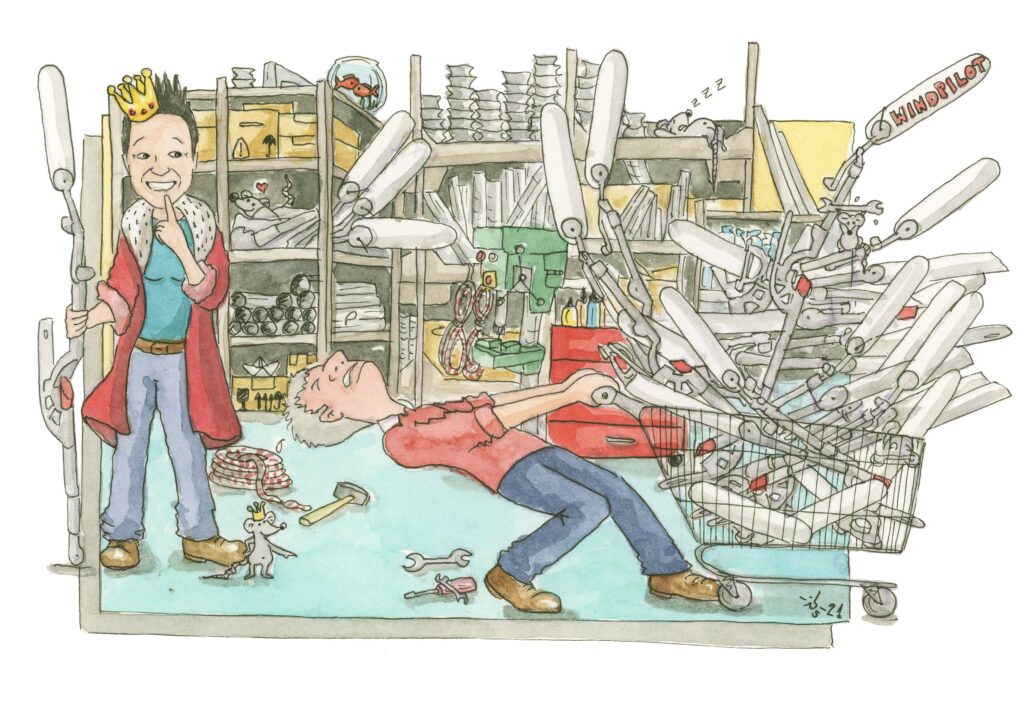 Long before I had any idea (or indeed any need to know) how I might go about it, I knew for certain that I wanted to be independent, to be my own boss. How much longer it will continue remains to be seen; you just never know! One thing I can be absolutely sure of though is that my cherished independence makes me a source of great frustration among certain journalists: not only do they have no way to make any money off me, but I maintain a lively dialogue with sailors directly too (something I regard more as fun than work), providing a wealth of information in the field of floating palaces and deep water completely free of charge. It maybe also doesn’t help that for the last 20 years, anyone so inclined has been able to access my technical guide on the subject (in any of six different languages) online at no cost. SELF-STEERING UNDER SAIL has been downloaded an extraordinary three million times over that period.
Long before I had any idea (or indeed any need to know) how I might go about it, I knew for certain that I wanted to be independent, to be my own boss. How much longer it will continue remains to be seen; you just never know! One thing I can be absolutely sure of though is that my cherished independence makes me a source of great frustration among certain journalists: not only do they have no way to make any money off me, but I maintain a lively dialogue with sailors directly too (something I regard more as fun than work), providing a wealth of information in the field of floating palaces and deep water completely free of charge. It maybe also doesn’t help that for the last 20 years, anyone so inclined has been able to access my technical guide on the subject (in any of six different languages) online at no cost. SELF-STEERING UNDER SAIL has been downloaded an extraordinary three million times over that period.
Obviously I do also pass those esteemed ladies and gentlemen who work their fingers to the bone at the keyboard for a living the occasional interesting little story without expectation of cash on delivery, in the time-honoured (and most enjoyable) fashion still current with us older types. This same principle I suppose underlies the blog I have been writing and curating for the last 14 years as a nourishing feast for the knowledge-hungry sailor tired of paywalls and compromised sources. This, indeed, is probably what sets my efforts apart from those of the information resellers, whose daily output necessarily has to follow the money. Theirs, as I see it, is a fundamentally flawed business model: they trade on their credibility, but it is the client with the least credible message who needs them the most…
 Whenever I sit down to write for my books and blog, in fact whenever I have a quiet moment before the cogs stop whirring for the day, my thoughts turn to how I might further tune my message so that it settles even more elegantly in the grey matter of sailors in thrall to the idea of blue water, ready to inform their purchasing decisions and guide them to the pleasures of effective self-steering at sea. Provided they have also absorbed the messages about KISS (keep it simple, stupid) and the importance of good trim, they should then be able to relax and make the most of the available bunk time. Why else would anyone engage in long-distance cruising?
Whenever I sit down to write for my books and blog, in fact whenever I have a quiet moment before the cogs stop whirring for the day, my thoughts turn to how I might further tune my message so that it settles even more elegantly in the grey matter of sailors in thrall to the idea of blue water, ready to inform their purchasing decisions and guide them to the pleasures of effective self-steering at sea. Provided they have also absorbed the messages about KISS (keep it simple, stupid) and the importance of good trim, they should then be able to relax and make the most of the available bunk time. Why else would anyone engage in long-distance cruising?
 Communication channels in direct marketing are wonderfully short because there are no intermediary resellers trying to earn a crust off the information provided. Engaging media support in pursuit of a larger audience costs money up front and involves a significant element of risk: what if the message is not quite conveyed as intended once entrusted to the media, for example, and what if the benefit obtained fails to justify the money invested? The substantial power imbalance here is difficult to overlook too, as is the risk of collateral damage to balance and impartiality if/because (thank you for your understanding!) editorial concerns intervene.
Communication channels in direct marketing are wonderfully short because there are no intermediary resellers trying to earn a crust off the information provided. Engaging media support in pursuit of a larger audience costs money up front and involves a significant element of risk: what if the message is not quite conveyed as intended once entrusted to the media, for example, and what if the benefit obtained fails to justify the money invested? The substantial power imbalance here is difficult to overlook too, as is the risk of collateral damage to balance and impartiality if/because (thank you for your understanding!) editorial concerns intervene.
 What are we to think when an author intentionally incorporates confounding comments (for pecuniary or other consideration) despite being in a position to know better? Is it courtesy, prejudice or pride, for example, that leads the journalistic objectivity we might reasonably expect to be laid aside? And where was the editor-in-chief when subjective judgments were slipping through to publication? Is it as simple as a demonstration of who really has the upper hand or are we seeing personal animosity given free rein? Perhaps the atmosphere in the writing business has simply become icier in response to competition, circulation trends or the quality of word-wranglers available? Perhaps we’ll never know.
What are we to think when an author intentionally incorporates confounding comments (for pecuniary or other consideration) despite being in a position to know better? Is it courtesy, prejudice or pride, for example, that leads the journalistic objectivity we might reasonably expect to be laid aside? And where was the editor-in-chief when subjective judgments were slipping through to publication? Is it as simple as a demonstration of who really has the upper hand or are we seeing personal animosity given free rein? Perhaps the atmosphere in the writing business has simply become icier in response to competition, circulation trends or the quality of word-wranglers available? Perhaps we’ll never know.
It does appear though that there really might, now and again, be an element of personal animosity at work, albeit carefully dressed up as objective comment – and the sheen of gravitas that comes with being able to publish on paper or in a formal online setting makes it difficult for even the discerning reader to contradict the “facts” served up ad hoc. Fortunately for me, I have my own channel through which to argue my case!
Former journalist with german YACHT magazin wrote about his opinion-never-again-with-a-wind-steering-system
The original text in German
https://www.yacht.de/en/opinion-never-again-with-a-wind-steering-system/
It must be a self-evident truth that the people behind a specialist magazine need to avoid taking their readers for fools for fear of losing the foundation of credibility on which their publication stands. Were it that simple! There are, it transpires, more subtle (possibly even more efficient as well) ways to foster misunderstanding. Take, for example, Katy Stickland’s recent report in Yachting Monthly about Abhilash Tomy and his experiences in the 2022 GGR.
YM: The biggest issue was with his Windpilot self steering gear. This model has a servo rudder, and by Cape Horn he had used all his spare pendulum blades, and was forced ‘to innovate’. He used a hatch cover from the saloon, the door of the heads and his spare rudder to fashion three different replacements, but these all broke. Eventually, he used the fortress stock of the anchor. ‘It fitted almost exactly, except it wasn’t really wide enough. As a result, the power was less but it really worked and it worked from Cape Horn to Les Sables d’Olonne,’ he explained.
Now, while these words are not untrue per se, as Katy must surely (and undoubtedly should) have understood very well, they fall a long way short of telling the whole story – and the omissions are, coincidentally or otherwise, tailor-made (tailor-omitted?) to damage one particular brand. The tailor ought to realise though that only sailors quite unfamiliar with the GGR are really at risk of being led astray: Abhilash had Bayanat over-canvassed for almost half the race, mainly because he only had two sets of reefing points in his mainsail but also because he was prepared to risk excess sail area in pursuit of higher daily mileages, a gamble that paid off for him in the end. Having so much sail aloft all the time meant constant excessive loads on the helm – loads that eventually proved too much for three pendulum rudder blades. Once Abhilash hit on the idea of replacing the pendulum rudder with the shank of a Fortress anchor, the Windpilot Pacific saw him safely to his destination despite the extraordinary demands placed on it (and then there are the thousands of sailors who have collectively covered millions of nautical miles without ever breaking a single pendulum rudder).
Abhilash’s drive and ambition simply proved too much for an aluminium rudder blade just 20 mm thick – and Katy was happy to report the consequences without enlightening readers as to their cause. Why would a yachting journalist consider it acceptable to leave her readers at a high risk of ending up misinformed? Some people, as we know, have sponsors to look after, but what forces could possibly be at work in this instance? It certainly doesn’t have to be this way. When PBO was readying its recent major report on windvane self-steering systems, for example, the author, Alison Wood, kindly shared it with me in advance. Old-school decency and respect have life in them yet.
Such “pinpricks” are though as nothing compared with the conduct of Don McIntyre, who, apparently motivated by a somewhat unconventional conception of his duties as race organiser as well as his contractual obligations to a sponsor (a very significant financial contributor), sought to compel his proteges – ideally all of them – to use the windvane self-steering system of his preferred brand. That a different brand was then “inadvertently” presented in a negative light in the wake of these events and in press releases reproduced more or less verbatim (ah, the convenience of copy-and-paste journalism) in international magazines while obvious shortcomings exposed in another product singularly failed to make the headlines reveals in stark relief the quid pro quo available for interested parties willing to cross the organiser’s palm with silver. Plenty of strong words fit the bill to describe such shabby arrangements. Unethical is undoubtedly one of them, and immoral might well be too
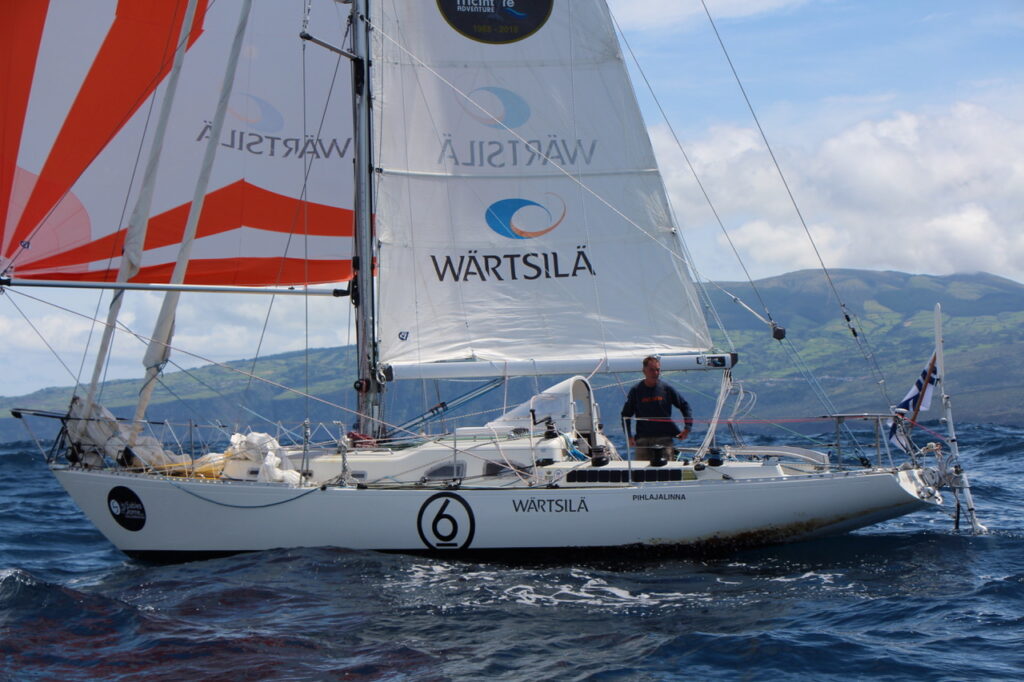
I regarded having the Windpilot Pacific installed on a total of seven boats over two editions of the GGR as an excellent test of the reliability of windvane self-steering. All of my systems made it to the end of their respective skipper’s race and the spare systems I supplied as a precaution never saw the light of day. Abhilash’s spare Pacific has ended up resting in peace at the bottom of the Indian Ocean, but even that sinking produced a highlight for me by demonstrating another advantage of the 270-degree arc of travel provided by my design. The succession of rollovers Abhilash suffered was so severe it left him with a broken back, and yet my Pacific survived it all intact (the plywood windvane having been “reefed” – that is to say snapped off – by the skipper in advance). As sad a tale as it is, the story of the loss of Thuriya had a silver lining for me because it proved once and for all that the dubious-at-best bad weather problem invented by a competitor chasing a slice of my market really was nothing more than a figment of his imagination, an iniquitous attempt to create uncertainty among buyers in the hope of luring more of them over to his own product. I always regarded this ruse as a low blow and have dismantled the entire nonsensical argument more than once in my various publications.
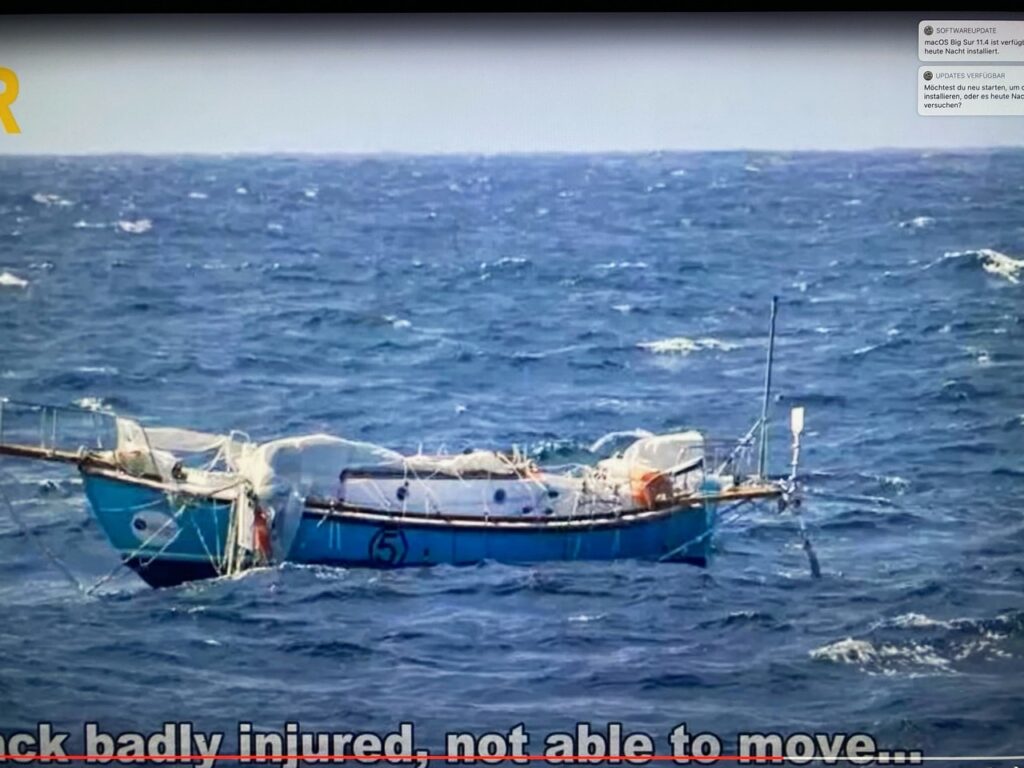
The whole story can be found in my book Windvane Report.
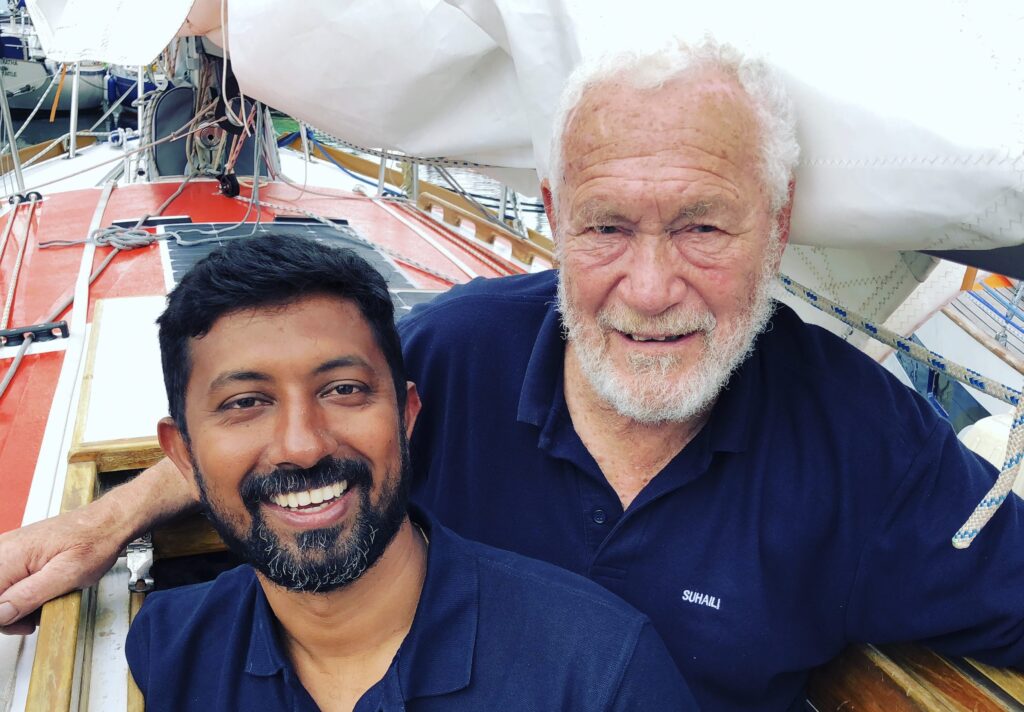
WINDVANE SELF-STEERING IN THE GGR: STATISTICS
GGR – systems on the 2018 start line
2 Aries,
3 Beaufort
7 Hydrovane
3 Monitor
5 Windpilot
Im Ziel angekommen
1. Jean-Luc van den Heede, Hydrovane
2. Mark Slats, Aries
3. Uku Randmaa, Hydrovane, Monitor
4. Istvan Kopar, Windpilot
5. Tapio Lehtinen, Windpilot
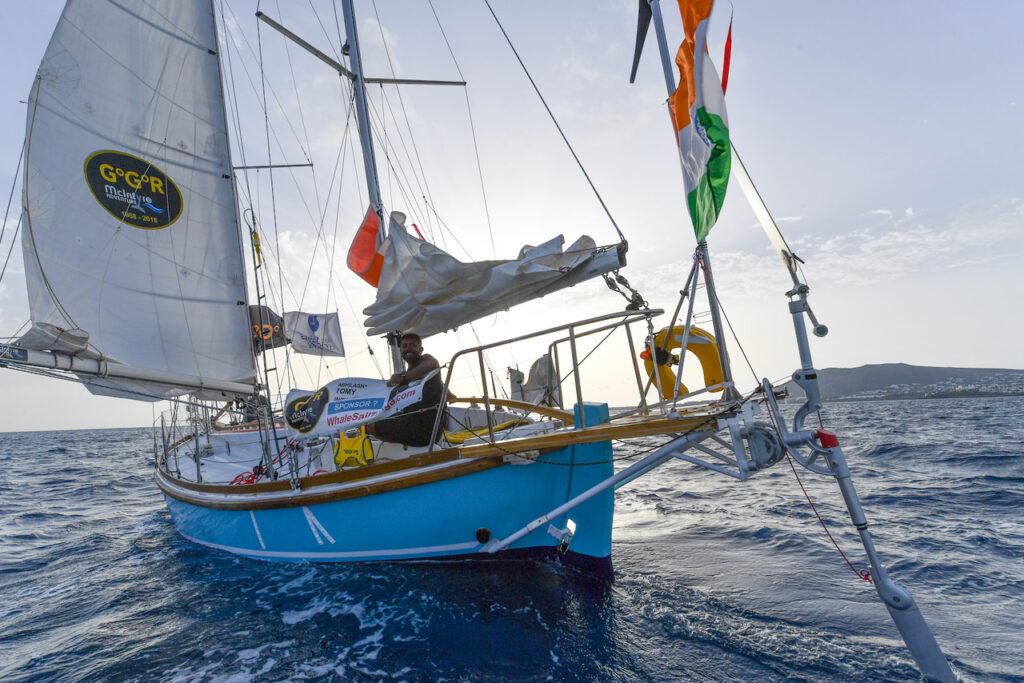
Failures and retirements:
Nabil Amra, Beaufort, Bruch der WSA
Francesco Cappelletti, Beaufort, Bruch der WSA
Philippe Péché, Beaufort, Bruch der WSA
Are Wiig, Monitor, mehrfacher Bruch Überlastungsschutz, Kenterung
Susie Goodall, Monitor, mehrfacher Bruch Überlastungsschutz, Interaktion zwischen JSD und WSA, Überkopf Kenterung, Aufgabe des Schiffes.
Windpilot systems surviving intact/lost while still functional
Abhilash Tomy, mehrere Kenterungen, Verlust beider Masten, Untergang
Istvan Kopar, zwölf Stürme >50kn, drei Kenterungen Ankunft im Ziel als 4.
Tapio Lehtinen, Ankunft im Ziel als 5.
Antoine Cousot, Abbruch in Rio de Janeiro aus persönlichen Gründen
Igor Zaretskiy, Abbruch in Freemantle Au aus gesundheitlichen Gründen
Alle Windpilot Segler waren mit einem kompletten System zur Redundanz ausgerüstet – sie blieben sämtlich unbenutzt.
GGR – systems on the 2022 start line:
2 Aries
12 Hydrovane
2 Windpilot
Reached the finish:
1. Kirsten Neuschafer, Hydrovane
2. Abhilash Tomy, Windpilot
3. Michael Guggenberger, Hydrovane
Simon Curwhen, Hydrovane Chichester Class
Jeremy Bagshaw, Windpilot Chichester Class
Failures and retirements:
Damien Guillou, Hydrovane mehrfacher Ruderbruch, Aufgabe
Ian Herbert-Jones, Hydrovane, Ruderbruch durch Interaktion JSD WSA, Durchkenterung, Aufgabe
Tapio Lehtinen, Hydrovane, Untergang des Schiffes
Pat Lawless, Aries Lagerschaden, Aufgabe
Simon Curwhen, Hydrovane, Bruch des Windfahnensupports, Zieldurchgang in Chichester Class
Changes of boat/system between 2018 and 2022:
PRB, Phillipe Péché, Beaufort = Bayanat, Abhilash Tomy, Windpilot
Métier Intérim, Antoine Cousot, Windpilot = Nuri, Michael Guggenberger, Hydrovane
Olleanna, Are Wiig, Monitor = Olleanna, Jeremy Bagshaw, Windpilot
Puffin, Istvan Kopar, Windpilot = Puffin, Ian Herbert-Jones, Hydrovane
Asteria, Tapio Lehtinen, Windpilot =A steria, Tapio Lehtinen, Hydrovane
THE NUMBERS GAME
Statistics can be twisted to prove just about anything you want to prove, of course, and I need no reminding that pride comes before a fall. That said, I do like the tale the numbers tell in this simple summary:
across the two editions of the GGR, Windpilot accounted for only around 20% (7 of 34) of the boats to make the start line, but a much more hefty 40% (4 of 10) of those to make it all the way to the finish. Perhaps I’m splitting hairs with these figures, but they certainly put a smile on my face at least
My experiences with Istvan Kopar and Don McIntyre at a personal level around the first edition of the GGR were beyond unpleasant, as a result of which I resolved not to supply competitors for any subsequent related events. We then ended up with two Windpilot-equipped boats in the next edition anyway, but only because I count.
Abhilash and Jeremy as good friends and both had had a Windpilot on the transom for years in any case.
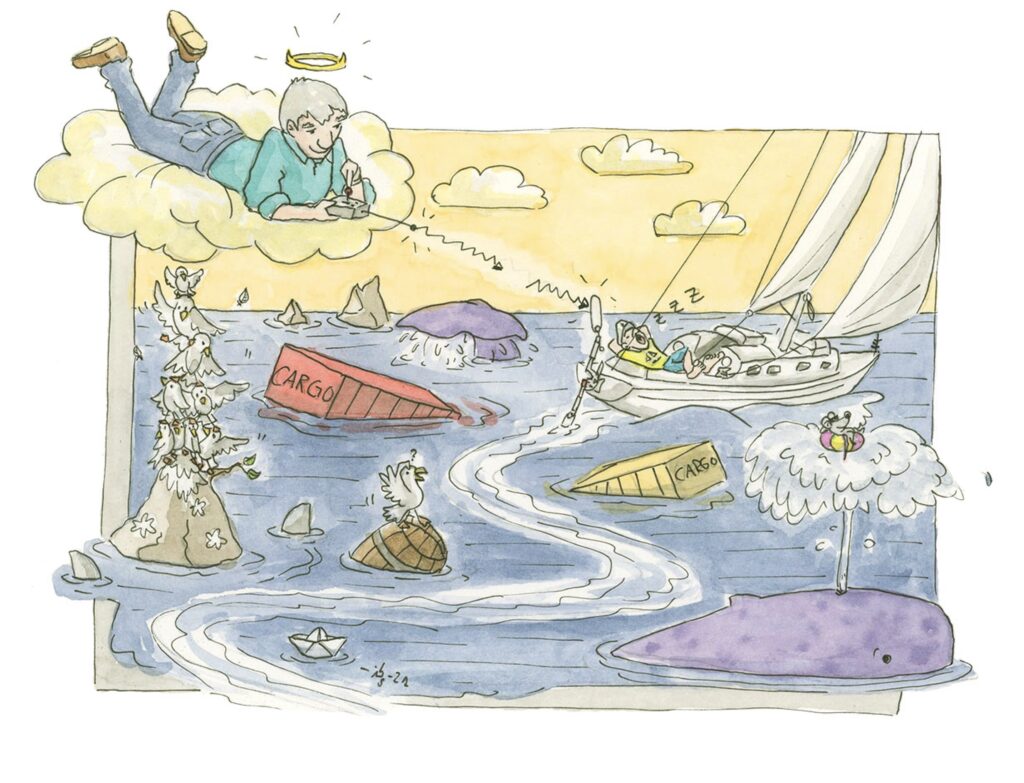 Back to marketing and the backdoor to the sailor’s brain
.
Back to marketing and the backdoor to the sailor’s brain
.
For more years than I care to remember, I would spend much of the autumn in the bottleneck and favoured jumping-off point for sun-hungry European sailors that is the Canary Islands. There is no better place to learn, especially at a time of year when the North is returning to cold and darkness.
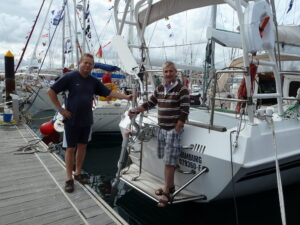 Working with Jimmy Cornell, whose Ovni turned out to be the first of an endless procession that I have equipped (we are now at more than 500 and counting), was all about good times. Jimmy sold his World Cruising business at the turn of the millennium, after which commercial imperatives began to replace fun at the top of the agenda. That was my impression anyway, especially when new proprietor Andrew Bishop let me know that if I wanted to carry on helping sailors preparing to cross the Pond, I would need to pay £5,000 to the organiser up front for the privilege.
Working with Jimmy Cornell, whose Ovni turned out to be the first of an endless procession that I have equipped (we are now at more than 500 and counting), was all about good times. Jimmy sold his World Cruising business at the turn of the millennium, after which commercial imperatives began to replace fun at the top of the agenda. That was my impression anyway, especially when new proprietor Andrew Bishop let me know that if I wanted to carry on helping sailors preparing to cross the Pond, I would need to pay £5,000 to the organiser up front for the privilege.
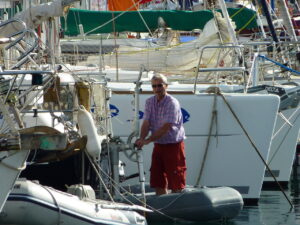 And he was serious too: I may have done 25 autumns in the Canaries serving the cruising community free of charge without even billing for my time (that my flight and hire car costs were tax-deductible sufficed, especially in light of the weather back home), but now I was apparently a cash cow to be milked.
And he was serious too: I may have done 25 autumns in the Canaries serving the cruising community free of charge without even billing for my time (that my flight and hire car costs were tax-deductible sufficed, especially in light of the weather back home), but now I was apparently a cash cow to be milked.
 A tough decision? Not really – and it helped that my wife had long since fallen out of love with flying and the idea of sharing a cramped metal tube with malodorous strangers (give her the sounds and smells of the countryside every time, birds, cows, dogs … all of it). My place in the ARC circus passed at that point to one of my competitors, who was prepared to stump up the necessary entry fee and has ever since been preaching the existential significance of emergency rudders in order to recoup his investment in the organising authority, which has kindly started strongly recommending that an emergency rudder be carried.
A tough decision? Not really – and it helped that my wife had long since fallen out of love with flying and the idea of sharing a cramped metal tube with malodorous strangers (give her the sounds and smells of the countryside every time, birds, cows, dogs … all of it). My place in the ARC circus passed at that point to one of my competitors, who was prepared to stump up the necessary entry fee and has ever since been preaching the existential significance of emergency rudders in order to recoup his investment in the organising authority, which has kindly started strongly recommending that an emergency rudder be carried.
This cunning marketing tactic, which cannot help but drive sales, works the world over and has accordingly been picked up by flotilla event organisers generally as a reliable way to extract a little more from their flock. Now is not the time to dwell on the practicality of yachts – yachts that in all honesty have no business far out on the cruel sea – carrying a small spare rudder in the hope that it might help the crew regain some measure of control if the main rudder – and all that surface area, lateral resistance and balance that it provides – should be lost. The world is a big place and so is the market for windvane self-steering. There is no need to chase after every last boat in the hope of ornamenting its transom – it all comes down to costs, benefits and the ratio of one to the other.
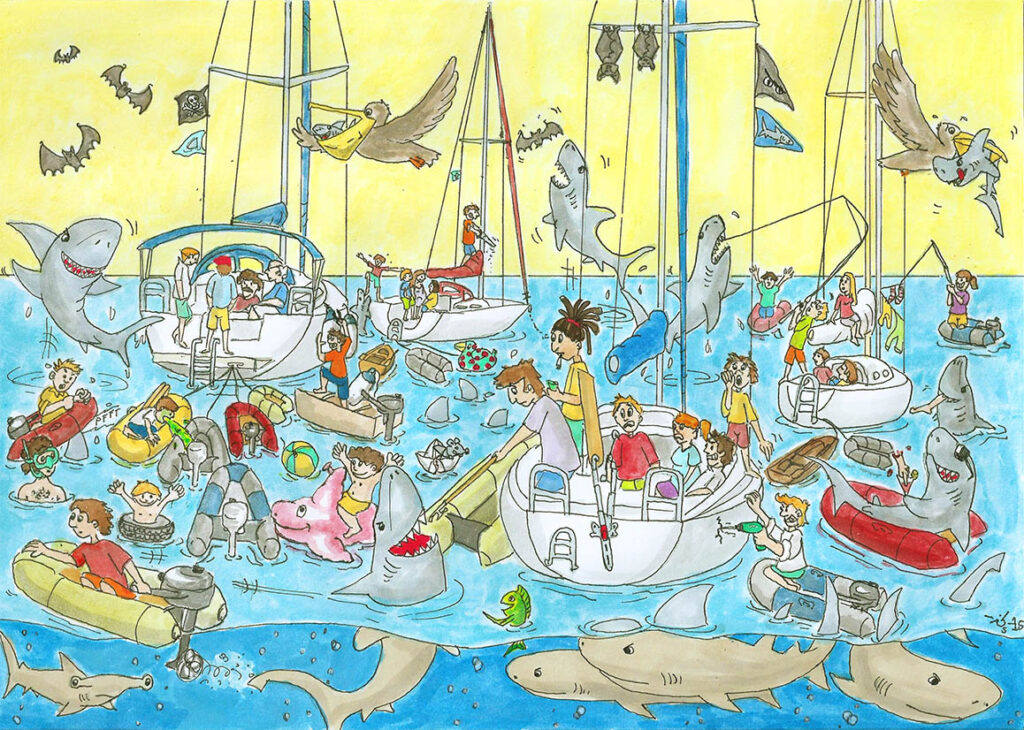 Personally, I place great weight on freedom as a benefit. It has always been one of my top priorities and is part of the reason I will not discount products for would-be resellers (which would be tantamount to charging the sailors I serve extra to cover my own marketing expenses). Unadulterated direct marketing is the only way, at least for so long as the decision is mine to make.
Personally, I place great weight on freedom as a benefit. It has always been one of my top priorities and is part of the reason I will not discount products for would-be resellers (which would be tantamount to charging the sailors I serve extra to cover my own marketing expenses). Unadulterated direct marketing is the only way, at least for so long as the decision is mine to make.
Dealing with information resellers has become more difficult, and definitely more awkward, because of a misunderstanding in some quarters as to where the balance of power lies, or should lie. I will not be tugging my forelock, thank you! Perhaps my willingness (or should that be compulsion) to speak my mind must shoulder a share of the blame for the signs of envy I cannot help noticing from time to time. Half a century in the shark tank of the marine industry has taught me lessons I would happily have forgone, except that I could not have been me and done what I have done and still avoided them.
So much for the frustrations, what about the joy? Well, the joy comes from my daily contacts with the sailors who buy my steering slaves, the great majority of whom neither expect – nor indeed offer – any deference in our interactions. This, for me, is how not just business but all human relationships should proceed: on the basis of integrity and mutual respect.
Peter Foerthmann
Hamburg, 15 October 2024

































